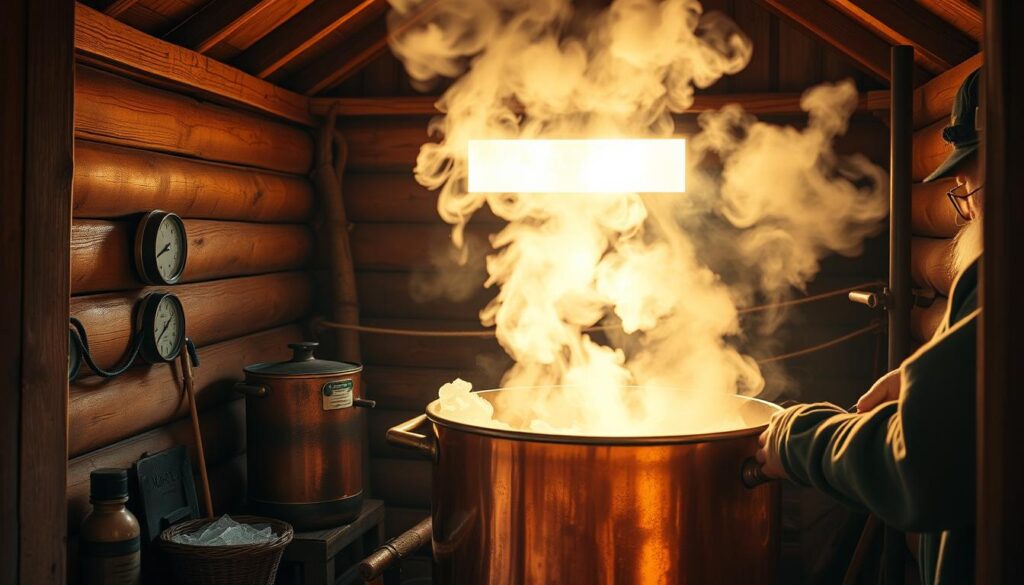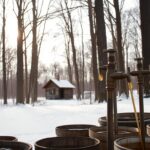Making great maple syrup needs precision, skill, and knowing how to control temperature. The boil temperature is key, turning raw sap into golden syrup. This syrup is loved by many in North America.
Temperature is very important for maple syrup’s quality, taste, and look. Sugarmakers with skill can make syrup that stands out. Every degree counts, from collecting sap to boiling it.
Maple syrup making is a mix of science and tradition. It’s about watching heat levels to concentrate sugars and flavors. Small changes can greatly affect the syrup, making temperature control very important.
This guide will explore the world of maple syrup boil temperature. You’ll learn about the science behind sap change, how to manage temperature, and the art of syrup making.
If you love food, want to make syrup, or improve your skills, knowing about boil temperature is key. It helps make syrup that truly shows maple’s sweetness.
Get ready to explore maple syrup making. Here, temperature is more than a number. It’s the secret to amazing flavor and quality.
Understanding the Science Behind Maple Syrup Production
Maple syrup making is a mix of nature and skill. It turns tree sap into golden syrup through science. Knowing the science helps syrup makers get it just right.
Chemical Composition of Maple Sap
Maple sap is mostly water with a special sugar mix. It has:
- 97-99% water
- 1-3% sugar content
- Trace minerals like calcium, potassium, and magnesium
Sugar Content and Density Relationships
The syrup’s density and quality depend on sugar levels. As water boils off, sugar gets more concentrated. This is why makers watch it closely.
| Sap Stage | Sugar Percentage | Density |
|---|---|---|
| Raw Sap | 2-3% | Light |
| Concentrated Sap | 8-10% | Medium |
| Finished Syrup | 66-67% | Heavy |
The Role of Heat in Concentration
Heat is key in making maple syrup. Precise temperature control turns sap into syrup. Boiling removes water, making it sweet.
Essential Equipment for Temperature Monitoring
Precision is key in making great maple syrup. The right tools help turn raw sap into golden syrup. This is why sugarmakers in maple-rich areas need the best equipment.
Choosing the right tools for measuring maple syrup processing temperature is important. You need to know about several key instruments:
- Digital Thermometers: Give quick, accurate readings for syrup processing temperature
- Traditional Mercury Thermometers: Reliable classics in syrup production
- Infrared Temperature Guns: Measure temperature without touching
- Hydrometer: Checks sugar density and concentration
Getting the best temperature for boiling maple sap needs precise tools. Professional sugarmakers use top-notch equipment for consistent syrup quality.
“Accuracy in temperature control separates good maple syrup from extraordinary maple syrup.” – Maple Syrup Production Expert
When picking temperature monitoring equipment, look for these features:
- Temperature range capability
- Accuracy (+/- 1 degree precision)
- Durability in high-heat environments
- Easy-to-read display
- Calibration options
Digital monitoring systems are the latest in maple syrup temperature control. They offer real-time data and remote tracking.
Keeping your temperature monitoring equipment in good shape is vital. It ensures reliable performance during the maple syrup production process.
Maple Syrup Boil Temperature: Key Phases and Stages
Crafting maple syrup is a delicate process that needs precise temperature control. The maple syrup boil temperature is key in turning raw sap into sweet syrup. Knowing the key phases helps sugarmakers get the syrup just right in consistency and flavor.
The maple syrup boiling point has three critical stages. These stages turn raw tree sap into liquid gold. Each stage needs careful attention and specific temperature control for quality production.
Initial Heating Phase
In the initial heating phase, raw maple sap starts its transformation. Sugarmakers warm the sap slowly, usually around 212°F (100°C). This stage removes water and starts concentrating the natural sugars.
- Temperature range: 190-212°F
- Primary goal: Initial water evaporation
- Sap becomes slightly thicker
Rolling Boil Stage
The rolling boil stage is the most critical part of maple syrup production. At this point, the syrup becomes more concentrated. Temperatures rise, and sugar content increases.
- Temperature range: 213-217°F
- Rapid liquid reduction occurs
- Bubbling becomes vigorous and consistent
Final Drawing Temperature
The final drawing temperature is the end of the maple syrup production process. Sugarmakers watch the temperature closely to get the syrup just right.
- Temperature range: 219-221°F
- Final sugar concentration achieved
- Syrup reaches ideal thickness
Mastering these temperature stages ensures high-quality maple syrup with rich flavor and optimal texture.
Optimal Temperature Ranges for Different Syrup Grades
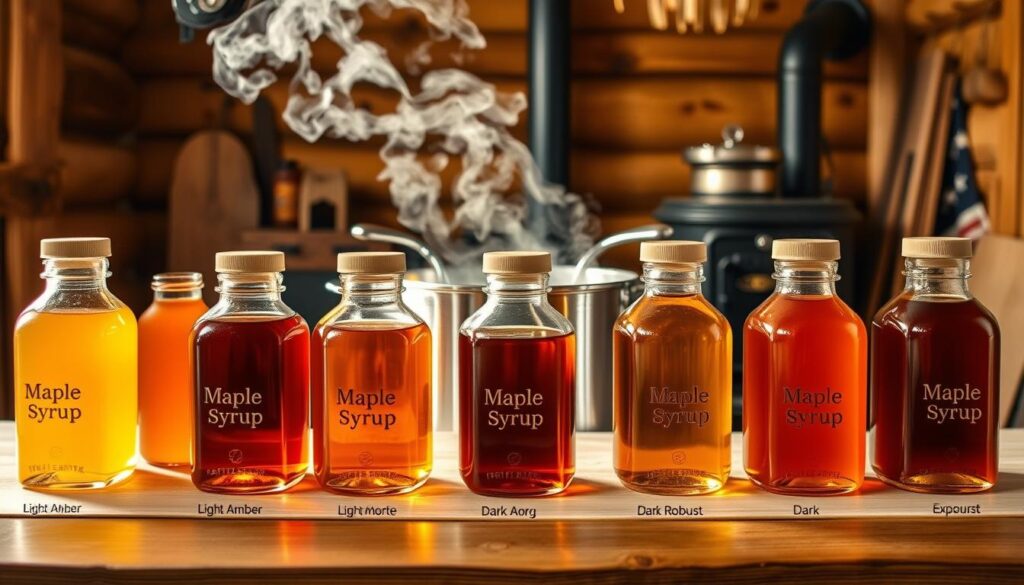
Making the perfect maple syrup needs careful temperature control. The right temperature affects the syrup’s grade, taste, and color.
Maple syrup’s cooking temperature changes with each grade. This creates special flavors that syrup lovers enjoy. Sugarmakers watch these temperatures closely to make top-notch syrup:
- Golden Color, Delicate Taste: Needs lower temperatures between 212-213°F
- Amber Color, Rich Flavor: Forms at slightly higher temperatures of 214-215°F
- Dark Color, Robust Taste: Gets from longer boiling at 216-218°F
Temperature control does more than just change color. It also changes the syrup’s molecules, making different flavors. These flavors show the true taste of maple syrup.
Precision is key: Even a single degree can shift the syrup’s entire character.
Experts in making maple syrup know it’s an art. They adjust the heat carefully. This makes each batch special and unique.
Common Temperature Control Challenges and Solutions
Maple syrup production needs precise temperature control. But, many factors can make it hard. Sugarmakers face challenges to keep syrup quality high. Knowing these issues is key to keeping syrup temperature right.
For successful syrup making, it’s important to know about temperature problems. These can affect the boiling process.
Weather Impact on Boiling
Weather greatly affects maple syrup making. Temperature changes can cause problems during boiling:
- Rapid temperature changes disrupt sap flow
- Humidity levels affect evaporation rates
- Wind can create uneven heating in evaporation pans
Altitude Adjustments
Elevation is important for syrup temperature control. Different heights need different boiling points:
| Altitude Range | Boiling Point Adjustment | Recommended Action |
|---|---|---|
| Sea Level to 1,000 ft | Standard 219°F | No adjustment needed |
| 1,000-2,500 ft | 217-218°F | Reduce boiling temperature |
| Above 2,500 ft | 215-216°F | Significant temperature reduction |
Equipment Calibration Issues
Accurate temperature monitoring needs good equipment. Regular calibration prevents inaccurate readings that can harm syrup quality. Sugarmakers should:
- Check thermometer accuracy annually
- Use digital temperature probes
- Perform routine equipment maintenance
By tackling these temperature control challenges, maple syrup makers can improve their process. This helps keep syrup quality high.
Best Practices for Maintaining Consistent Temperature
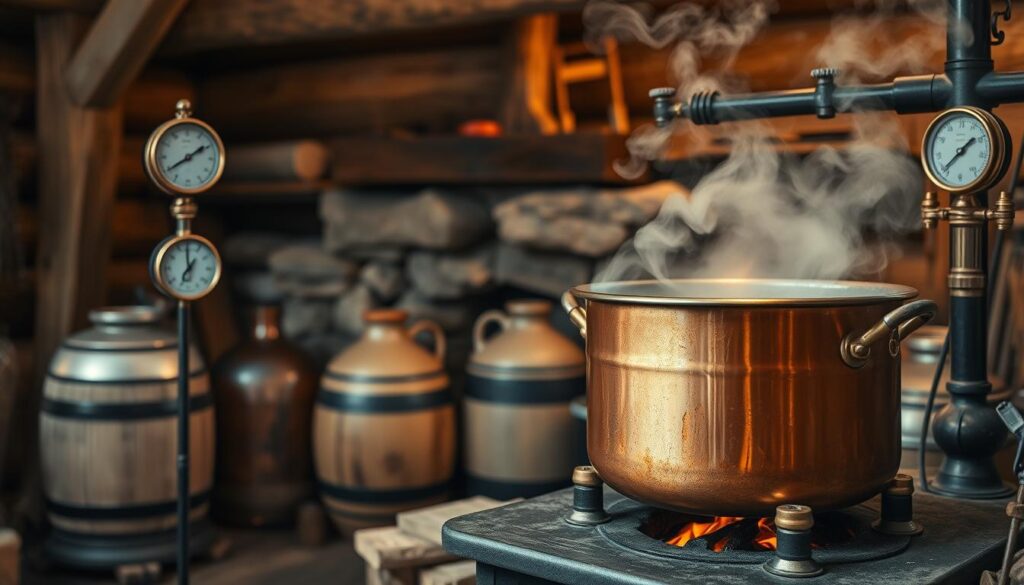
To get the best maple syrup, you need to be precise with temperature. Sugarmakers know that keeping the syrup processing temperature steady is key. They use special techniques to keep the temperature stable during production.
Starting with fire management is important. Experts suggest these steps:
- Choose a heat source that works well and stays consistent
- Watch the flame’s strength closely
- Make sure the heat spreads evenly across the evaporator
- Adjust the temperature slowly
Having the right tools is also essential. Digital thermometers and advanced systems help track temperature changes accurately. Tracking temperature in real-time helps avoid overcooking and keeps the syrup’s flavor intact.
Here are more strategies for controlling temperature:
- Regularly check and calibrate your equipment
- Use several temperature measuring points
- Keep a detailed temperature log
- Train your team on precise temperature management
Knowing how heat affects sugar concentration is important. Sugarmakers make small changes to improve syrup quality. Keeping the boil temperature just right requires constant focus and knowledge of the syrup-making process.
“Temperature is the silent artist in maple syrup creation” – Traditional Sugarmaker’s Wisdom
The Impact of Boiling Temperature on Syrup Quality
Maple syrup making is a delicate art where temperature is key. The right boiling temperature affects the syrup’s flavor, color, and texture. This makes controlling the temperature very important for sugarmakers.
Understanding how boiling point and quality are linked is complex. It requires paying close attention to several important factors:
Flavor Development
Temperature greatly affects maple syrup’s flavor. Different heat levels bring out unique tastes:
- Lower temperatures produce lighter, more delicate flavors
- Higher temperatures create deeper, more robust taste notes
- Precise temperature control prevents bitter or burnt undertones
Color Formation
The boiling point of maple syrup also affects its color. As temperatures rise, the syrup changes color:
- Lighter temperatures result in golden, mild-colored syrups
- Extended boiling produces darker, more concentrated amber hues
- Extreme temperatures can lead to unwanted caramelization
Texture Considerations
Temperature control is essential for the syrup’s consistency. Sugarmakers need to monitor the heat closely to achieve:
- Smooth, even viscosity
- Proper sugar concentration
- Ideal crystallization prevention
Mastering the best temperature for boiling maple sap is an art that combines scientific precision with traditional craftsmanship.
Safety Measures During the Boiling Process
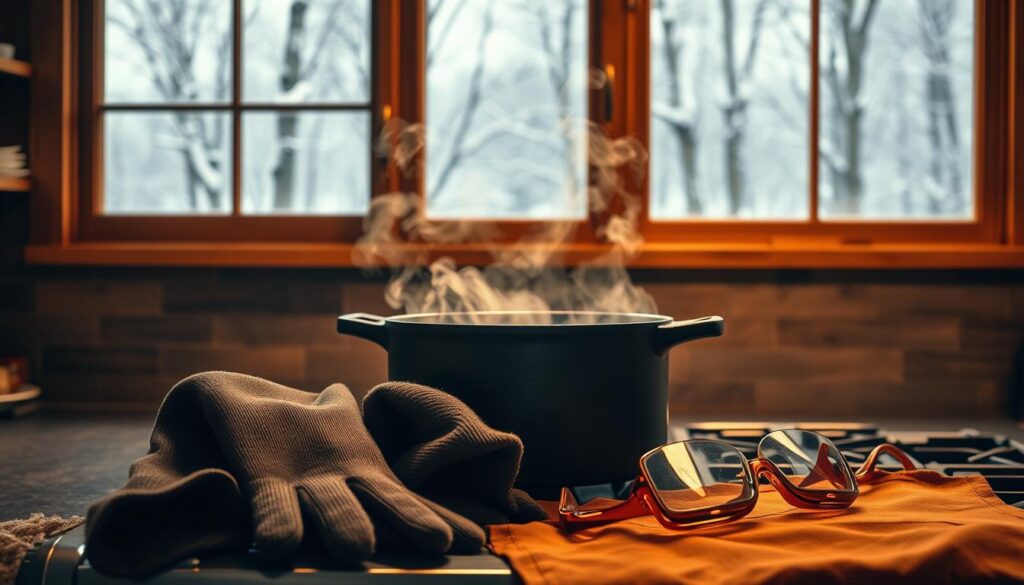
Producing maple syrup requires working with very high temperatures. This calls for careful attention and strict safety rules. The boiling temperature can get extremely high, making it vital to wear protective gear and handle things carefully.
Important safety steps when managing the maple syrup cooking temperature include:
- Wearing heat-resistant gloves and protective eyewear
- Maintaining a clear workspace around boiling equipment
- Using long-handled tools to prevent steam burns
- Installing fire extinguishers near boiling stations
Steam management is a big safety challenge in maple syrup production. Experts say it’s key to have good ventilation to lower risks from hot steam. Spaces that are closed off can quickly become dangerous when dealing with high-temperature boiling.
“Safety isn’t expensive, it’s priceless” – A guiding principle for maple syrup producers
Checking equipment is very important to avoid accidents. It’s good to regularly inspect boiling pans, thermometers, and heat sources. This helps spot any dangers early on. Sugarmakers should do a full check of their equipment before starting the season.
Training and knowing about safety is also critical. New maple syrup makers need to learn about the dangers of high-temperature cooking. They should create strong safety plans that fit their production area.
Advanced Temperature Monitoring Technologies
Modern maple syrup producers are changing the game with new tech. Advanced systems now track temperature better than ever before. This makes the syrup-making process more precise and efficient.
Digital Monitoring Systems
Digital temperature monitoring has changed maple syrup production. These systems give real-time data on the best temperature for syrup evaporation. Sugarmakers can now:
- Get exact temperature readings right away
- Keep a record of past temperatures
- Spot quick temperature changes
- Keep syrup quality consistent
Smart Temperature Controls
Smart temperature control uses advanced sensors and auto-adjustments. These systems can adjust heat levels on their own. This keeps the syrup-making temperature just right, with less need for human help.
Remote Monitoring Options
New remote monitoring tech lets sugarmakers check on their syrup from anywhere. Smartphone apps and cloud platforms offer:
- Instant temperature alerts
- Full production data
- Analytics on performance
- Quick alerts for big temperature changes
By using these advanced tech tools, maple syrup makers can improve their work. They get better efficiency, consistency, and quality in their syrup.
Troubleshooting Temperature-Related Issues
Maple syrup making needs precision, mainly in managing the boiling temperature. Sugarmakers often face temperature challenges that affect the syrup’s quality and taste.
Spotting common temperature problems is key for making great maple syrup. Here are some tips to help:
- Inconsistent Heat Distribution: Check your heat source for even flame or contact with the boiling pan
- Calibrate thermometers regularly to ensure accurate temperature readings
- Monitor ambient temperature and adjust heating as needed
Temperature changes can greatly impact syrup density and sugar content. Sugarmakers should look out for these signs:
- Uneven boiling patterns
- Unexpected color changes
- Crystallization during processing
Experts suggest using digital temperature monitoring systems. These tools help track boiling conditions accurately, reducing mistakes and ensuring syrup quality.
“Precision in temperature control separates good maple syrup from exceptional maple syrup.” – Maple Syrup Experts Association
Quick fixes can save a batch from failure. Always keep a steady heat source and watch temperature closely during syrup making.
Environmental Factors Affecting Boil Temperature
Maple syrup processing temperature is influenced by several key environmental factors. These factors can greatly affect the production process. Understanding them helps sugarmakers adjust their boil temperature and keep quality high.
Maple syrup production is a delicate art. It requires careful attention to environmental conditions. These conditions can change the boiling process. Skilled producers know that external factors are key to getting the perfect boil temperature.
Seasonal Variations and Sap Composition
Seasonal changes have a big impact on maple syrup processing temperature. Each stage of the maple season brings its own challenges:
- Early season sap has more sugar
- Late-season sap is more diluted and needs longer boiling
- Temperature changes affect sap flow and sugar levels
Atmospheric Pressure Effects
Atmospheric pressure also affects maple syrup boil temperature. Producers must adjust for these changes:
- Higher altitudes lower sap boiling point
- Changes in barometric pressure can change evaporation rates
- Different elevations need precise temperature adjustments
Professional sugarmakers use advanced monitoring equipment. They track these subtle environmental influences. This helps them keep the maple syrup processing temperature consistent.
Tips for Small-Scale vs Commercial Production
Maple syrup making is very different for small and big producers. Knowing how to control temperature is key for quality and efficiency at any scale.
The ideal temperature for boiling maple sap is the same. But, the tools and methods used by small and large producers are quite different.
- Small-Scale Production Challenges:
- Limited equipment precision
- Manual temperature monitoring
- Smaller batch sizes
- Commercial Production Advantages:
- Advanced digital temperature controls
- Automated monitoring systems
- Large-scale evaporation equipment
The boiling point for maple syrup is usually between 219-221 degrees Fahrenheit. Small producers need good thermometers. Big operations use high-tech sensors.
| Production Scale | Temperature Monitoring | Equipment Cost |
|---|---|---|
| Small-Scale | Manual digital thermometer | $50-$200 |
| Commercial | Automated digital systems | $5,000-$50,000 |
Keeping the maple syrup boiling point precise is vital for quality, no matter the size. Producers must adjust their methods to fit their setup.
Precision is the key to exceptional maple syrup, whether you’re processing 10 or 10,000 gallons.
Conclusion
Knowing the maple syrup boil temperature is key to making great syrup. Turning maple sap into golden syrup needs careful temperature control. Every step, from heating to the final draw, is important for the best flavor and quality.
Both big and small producers see maple syrup cooking temperature as an art. They use new tech and old ways to make perfect syrup. Getting the temperature right affects the syrup’s sweetness and taste, which is vital for maple syrup lovers.
Good maple syrup makers spend time learning about temperature, equipment, and the environment. They work hard in small shacks or big factories, always aiming for perfection. By following this guide, they can make syrup that stands out.
The maple syrup world keeps growing, and controlling temperature is always important. Using new tech and old methods keeps this natural sweetener loved by many.

